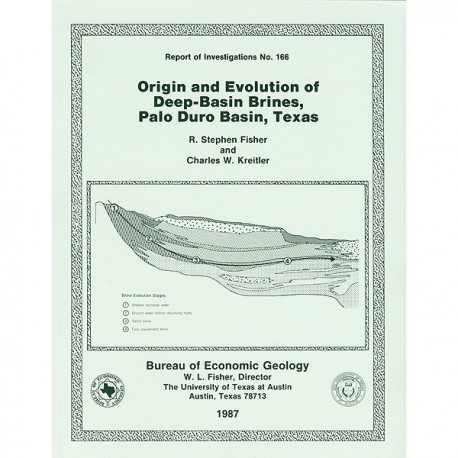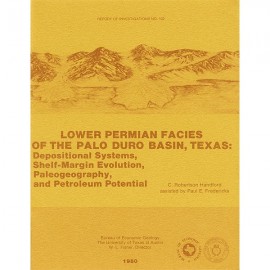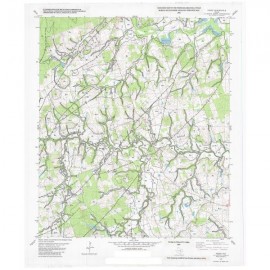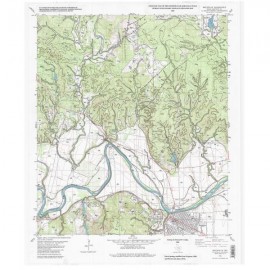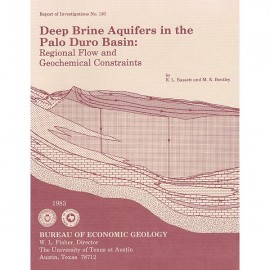Reports of Investigations
-
Books & Reports
- Reports of Investigations
- Guidebooks
- Udden Series
- Geological Circulars
- Down To Earth
- Atlases of Major Oil and Gas Reservoirs
- Texas Memorial Museum Publications
- Environmental Geologic Atlas of the Texas Coastal Zone
- Mineral Resource Circulars
- Other Reports
- Seminars and Workshops
- Handbooks
- Submerged Lands of Texas
- Symposia
- Annual Reports
- Open File Reports
-
Maps & Cross Sections
- Thematic Maps
- Miscellaneous Maps, Charts & Sections
- Geologic Atlas of Texas
- STATEMAP Project Maps
- Geologic Quadrangle Maps
- Cross Sections
- Highway Geology Map
- Energy and Mineral Resource Maps
- Shoreline Change and Other Posters
- Wilcox Group, East Texas, Geological / Hydrological Folios
- Bouguer Gravity Atlas of Texas
- River Basin Regional Studies
- Featured Maps
- Posters
- Teachers & the Public
-
Geological Society Publications
- Gulf Coast Association of Geological Societies
- Alabama Geological Society
- Austin Geological Society
- Corpus Christi Geological Society
- Houston Geological Society
- Lafayette Geological Society
- Mississippi Geological Society
- New Orleans Geological Society
- South Texas Geological Society
- GCS SEPM Publications
- Historic BEG & UT Series
Origin and Evolution of Deep-Basin Brines, Palo Duro Basin, Texas
RI0166
For a downloadable, digital version: RI0166D.
RI0166. Origin and Evolution of Deep-Basin Brines, Palo Duro Basin, Texas, by R. S. Fisher and C. W. Kreitler. 33 p., 25 figs., 3 tables, 2 appendices, 1987. ISSN: 0082335X: Print.
To purchase this publication as a downloadable PDF, please order RI0166D.
ABSTRACT
Porous and permeable strata of the Deep-Basin Brine aquifer underlie bedded evaporites that are being considered as repositories for high-level nuclear waste isolation in the Palo Duro Basin, Texas Panhandle. Formation-water samples collected from four U.S. Department of Energy test wells and from two wells drilled by independent oil and gas companies in the basin were analyzed for chemical and isotopic compositions to characterize the geochemical environment, determine the origin and compositional evolution of the water, and augment previous results of hydrologic investigations of ground-water flow directions and flow times.
Formation waters are sodium chloride brines that contain 140 to 290 g/L total dissolved solids, primarily as a result of contact with halite. Concentrations of major and minor ions appear to be controlled by equilibrium with calcite, dolomite, gypsum or anhydrite, celestite, low albite, microcline, and sodium smectite. High sodium activities drive ion exchange reactions, which, coupled with maintenance of chemical equilibrium, elevate the concentrations of divalent cations and lower the concentrations of dissolved sulfate and carbonate species. Brines from wells in the central and eastern parts of the basin are in or near oxygen isotopic equilibrium with calcite at subsurface temperatures, whereas brines from the western and northwestern margins of the basin are isotopically unequilibrated with calcite host rock.
Evolution of deep-basin brines is interpreted from chemical and isotopic compositions, and interpretations are integrated with results of previous geologic and hydrologic investigations. Brines from the western and northern Palo Duro Basin acquired salinity by dissolving halite along a lateral flow path from recharge at outcrop. Brines from the central and eastern Palo Duro Basin originated as either evaporatively concentrated seawater or recharge fluid that achieved trace element and isotopic equilibrium with host rock because of long flow paths and residence times. Regional chemical and isotopic compositional variations confirm the results of hydrologic modeling. Brines in the western and northern parts of the basin are recharged from the west and southwest, where siliciclastic rocks predominate in the recharge zone. Brines in the central and eastern parts of the basin are recharged from the south and southwest, where carbonate rocks predominate. Although hydrologic models indicate a potential for significant cross-formational flow through overlying evaporite strata into the deep-basin ground-water system, no unequivocal evidence of volumetrically important mass transfer is indicated by the chemical or isotopic compositions of the samples analyzed.
Keywords: Palo Duro Basin, Texas, deep-basin brines, formation water, hydrogeochemistry, mineral equilibria, stable isotope, chemical evolution
CONTENTS
Abstract
Introduction
Geologic Setting
Hydrologic Setting
Regional Hydrologic System
Recharge, regional flow, and discharge
Hydrologic communication within aquifer units
Age of fluids--hydrologic considerations
Chemical and Isotopic Composition of Deep-Basin Brines
Samples and locations
Collection and analytical procedures
Results of analyses: total salinity and chemical compositions
Results of analyses: isotopic compositions
Mineralogic Controls on Brine Composition
Equilibrium relations
Carbonate minerals
Sulfate minerals
Silicate minerals
Redox conditions
Oxygen and hydrogen isotopic compositions
Origin and Evolution of Deep-Basin Brines
Source of water and dissolved solutes
Case 1. Residual Permian evaporite fluids
Case 2. Vertical recharge
Case 3. Lateral recharge
Ion exchange effects on brine composition
Vertical variations in brine compositions
Summary and Conclusions
Geochemistry Implications for high-level nuclear waste isolation
Acknowledgments
References
Appendices
1. Chemical and isotopic compositions of deep-basin brines
2. Composition of dissolved gases in deep-basin brines
Figures
1. Map showing well locations and major structural elements of the Palo Duro Basin
2. Cross section showing major geologic and hydrogeostratigraphic divisions of Palo Duro Basin sedimentary rocks
3. Regional flow pattern of the Wolfcamp brine aquifer
4. Plot of oxygen and hydrogen isotopic compositions of deep-basin brines
5. Plot of oxygen isotopic composition versus depth of deep-basin brines
6. Plot of computed saturation index of brines with respect to calcite versus measured pH
7. Plot of computed saturation index of brines with respect to dolomite versus measured pH
8. Ion activity diagram showing the stability fields of minerals in the system HCl-H2O-Al2O3-K2O-Na2O-SiO2 at 25° and 60°C with logarithm activity H4SiO4 = -2. 70
9. Plot of logarithm Ca+2 versus logarithm Br- of deep-basin brines
10. Plot of logarithm SO4-2 versus logarithm Br- of deep-basin brines
11. Plot of logarithm Mg+2 versus logarithm Br- of deep-basin brines
12. Plot of logarithm K+ versus logarithm Br- of deep-basin brines
13. Plot of logarithm Ca+2 +Mg+2 +Sr+2 -SO4-2-alkalinity versus logarithm Br- of deep-basin brines
14. Plot of logarithm Na+ versus logarithm Br- of deep-basin brines
15. Plot of logarithm er versus logarithm Br- of deep-basin brines
16. Plot of chloride concentration versus depth below overlying halite
17. Plot of Cl:Br ratio versus oxygen isotopic composition of deep-basin brines
18. Compositional evolution of major ionic concentrations
19. Plot of sodium deficiency (mCl--Cl-Cl-) versus the sum of major divalent cations
20. Plot of sodium deficiency (mCl--mNa+) versus Cl-
21. Plot of sodium deficiency (mCl--mNa+) versus the sum of sulfate and alkalinity
22. Plot of sodium deficiency (mCl--mNa+) versus oxygen isotopic composition of deep-basin brines from Oldham and Deaf Smith Counties
23. Plot of sodium deficiency (mCl--mNa+) versus hydrogen isotopic composition of deep-basin brines from Oldham and Deaf Smith Counties
24. Line showing the change in brine hydrogen isotopic composition as the degree of clay alteration proceeds from 0 to 100 percent, superimposed on the ᵟ18O versus ᵟD compositions of deep-basin brines
25. Plot of sodium deficiency (mCl--mNa+) versus strontium isotopic composition
Tables
1. Generalized stratigraphic column, depositional environment, and hydrologic properties of Palo Duro Basin strata
2. Calculated saturation index of deep-basin brines with respect to calcite and dolomite, measured pH values, computed carbon dioxide partial pressure in atmospheres required for calcite equilibrium, and computed pH at equilibrium with calcite
3. Calculated saturation index of deep-basin brines with respect to anhydrite and celestite
Citation
Fisher, R. S., and Kreitler, C. W., 1987, Origin and Evolution of Deep-Basin Brines, Palo Duro Basin, Texas: The University of Texas at Austin, Bureau of Economic Geology, Report of Investigations No. 166, 33 p.
